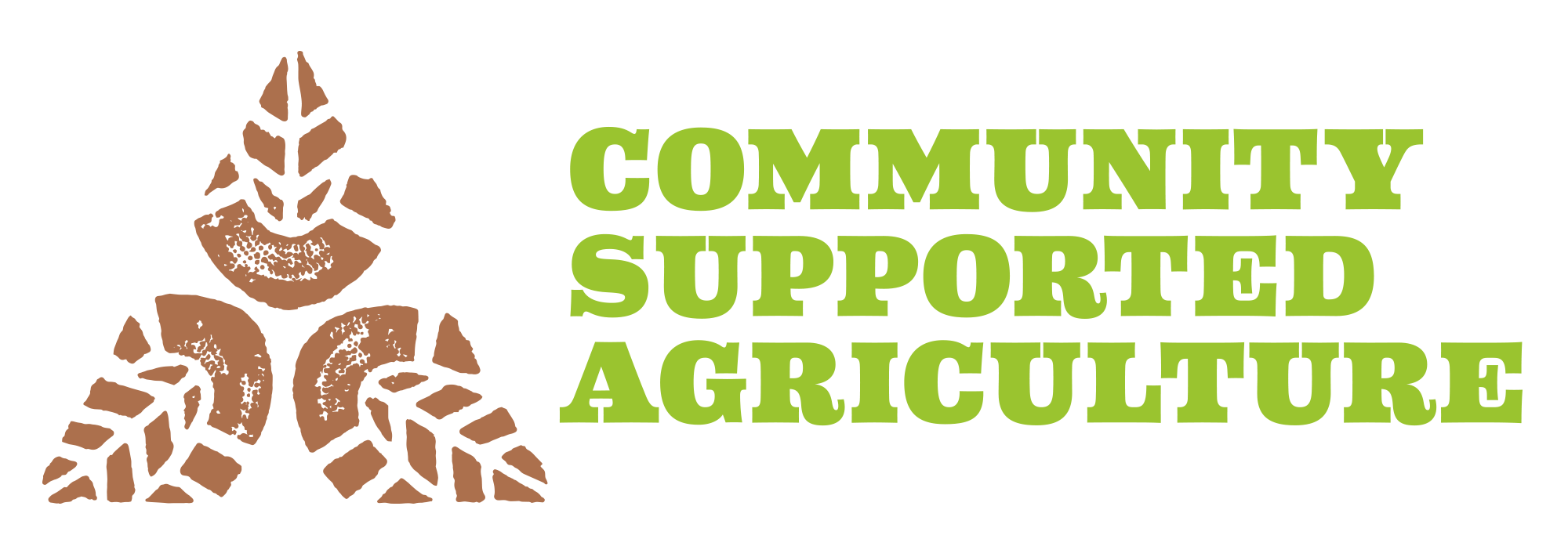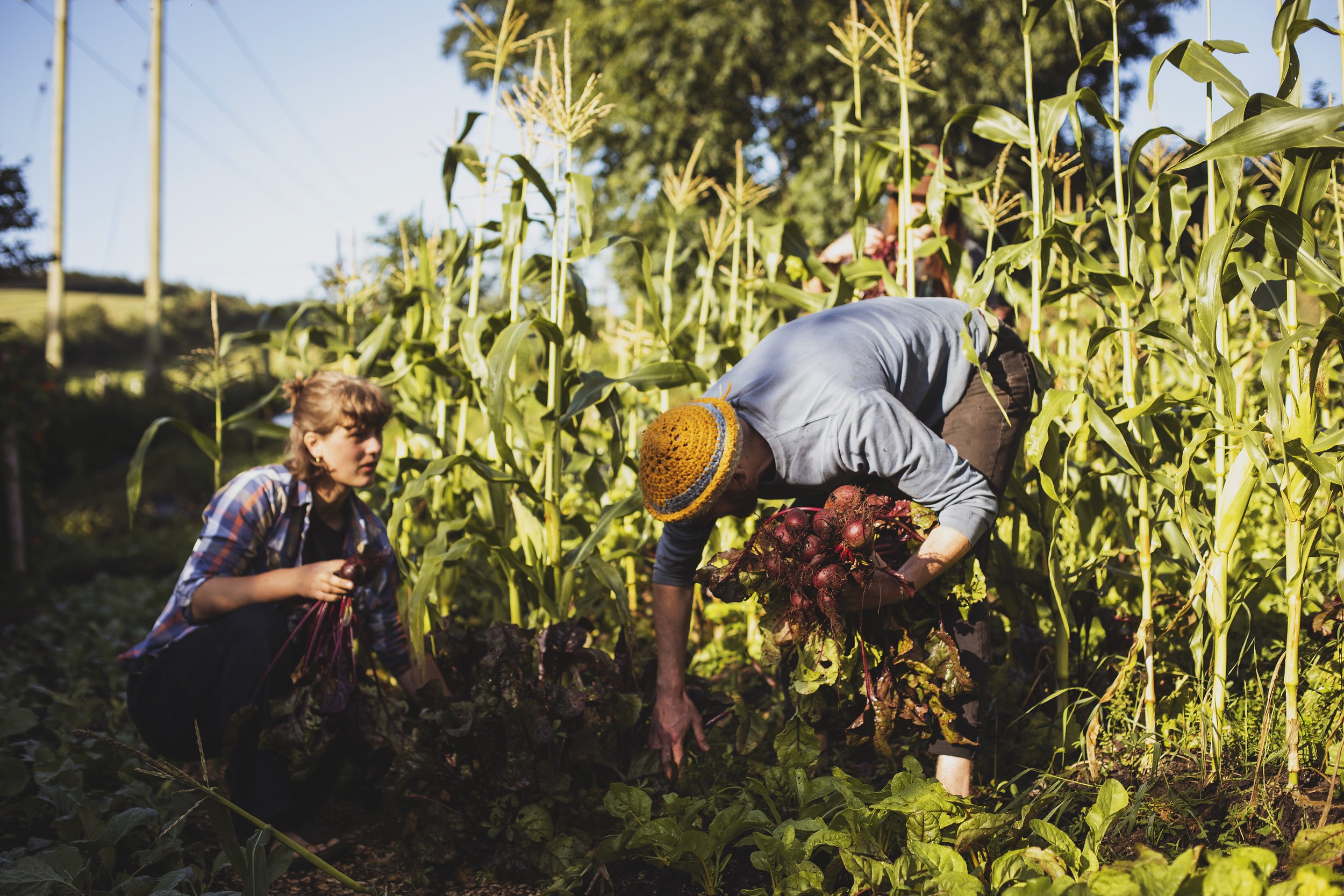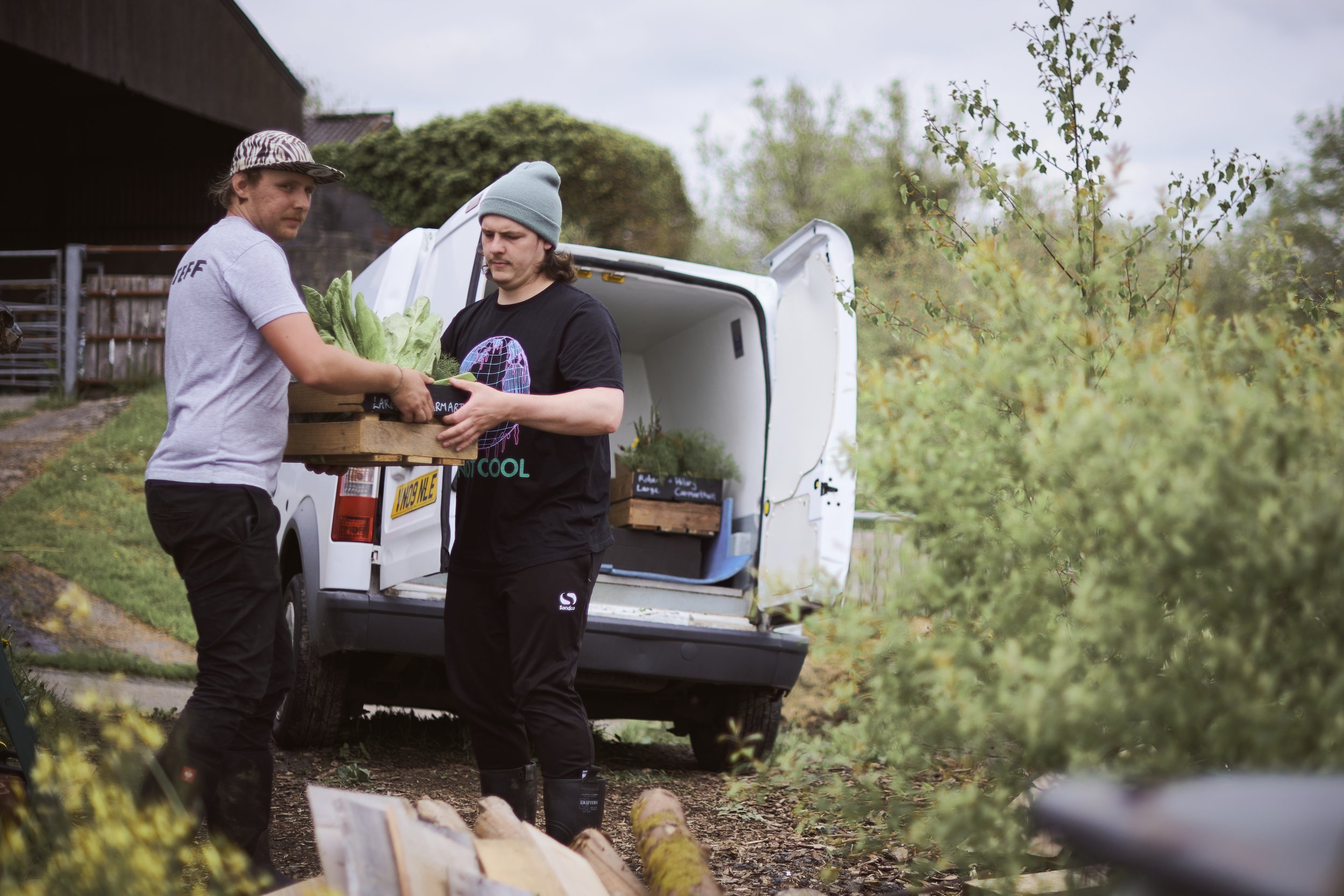‘Food with the Farmers Face on It’ | Why Community-Supported Agriculture (CSA) is the Future
Once a month, our founder, Abel, is going to write a longer piece for this blog in a series called ‘Scribblings from Beyond the Veg’, where he’ll share some of the soul of Glasbren, the threads that weave our little project on the land in West Wales with some of the bigger questions of our times…..
We feed 60 households between the Taf & Tywi rivers in West Carmarthenshire, Wales with a weekly share in the harvest, a box of fresh, locally-grown and ecological veg, herbs, salads and wild foods through something called a Community -Supported Agriculture (CSA) scheme.
As our 2021 CSA season season comes to an end, I wanted to explore this unique model for food and farming in a little more detail, get down some of the reflections I’ve had driving veg around the rolling green hills of our catchment through a pandemic and share with you why we think CSA holds the key to a resilient and regenerative future.
‘Far More Than Vegetables’ - What is Community-Supported Agriculture (CSA)?
The Community Supported Agriculture (CSA) model offers a radically new kind of relationship between consumers and producers based on mutual trust, transparency and building a better, kinder, more resilient food system.
Far beyond just a weekly share of vegetables, CSA is the chance to reimagine how we buy food, how we value it and our relationship with the people & land that grows it. It’s a kinder, more ethical and democratic business model that supports community-building, culture and the regeneration of the land. It has built in resilience and the capacity to address localised food poverty and inequality, and delivers exquisitely on the 3 core ethics of permaculture - Earth Care, People Care and Fair Share. We think that makes it a pretty special and unique experience.
Do you remember a time when you knew your family doctor personally, and they knew every member of the community by name and story? Well, as CSA farmers, we know all of our members in the same way. As I drive around on deliveries or meet our members on the doorstep, we share our lives, stories and the week’s successes and failures on the land. I have a genuine affection and care for all of them. Some have become friends. Many are pledged for the long term.
‘Food with the Farmers Face on It’ - The Roots of CSA
The CSA movement began in the UK in the late-1990s to counter the negative effects of industrial agriculture by reconnecting people with fresh local food produced with ecological farming methods, but it’s origins are older, and rooted in ancient, indigenous socioeconomic models for sharing the harvest, mutual aid and food equity. But CSA as we know it, though, has it’s roots across in a few different places. In Japan in the 1960s, a group of women wanted to find a way to distribute veg to their friends and families amidst a loss of farmland and farmers to the cities. They called them ‘Teikei’ schemes, literally meaning ‘food with the farmers face on it’. CSA can also be attracted to African American farmers in the 1960s. Booker T Whatley, an agricultural professor at Tuskegee University, became devoted to promoting regenerative agriculture and improving the livelihood of farmers through direct marketing. Movements such as “Pick-Your-Own” and “Farm-to-Table” are thanks to Dr. Whatley’s incredible innovation and his understanding of the intersection of organic agriculture and social justice.
Dr. Whatley created “clientele membership clubs” which can be seen as the beginning of CSA. These clientele membership clubs were, as stated in a 1982 interview, “the lifeblood of the whole setup. It enables the farmer to plan production, anticipate demand, and, of course, have a guaranteed market. However, that means the grower had better work just as diligently at establishing and maintaining the club as at producing the crops.” He advocated for planting clover to add organic matter and nitrogen to the soil to prevent soil erosion and in turn provide food for honeybees. He even promoted how small farms create a play area for children, making his clientele memberships a true family affair. You can see in the work of Booker T Whately the inspiration for the CSA approach to farming - transparency, member involvement, affordable food and the regeneration of land.
What Can We Rely On? ~ Resilience in Crisis
“CSAs have shown for years how to build resilience within communities, and this is something that has also been highlighted by the COVID-19 crisis ”
Just last night, as the Omnicron variant of COVID-19 spreads, I witnessed someone throwing two large loading trolleys full of toilet paper into their car outside a local supermarket. The hoarding begins again. Scenes of people hoarding toilet paper and canned goods, or fighting over petrol at the pumps have become familar in the times we are living in. It’s easy to conclude that indicidualism and selfishness thrive in a time of crisis.
But rather than a dog-eat-dog story of hoarding and looting, competition and violence, we’ve all seen a different reality playing out in our communities. Crises like the COVID pandemic offer the opportunity for the spirit of altruism, solidarity, community in all of us to express itself - and Community Supported Agriculture is the perfect home for that expression. It acknowledges that our wellbeing is connected to the wellbeing of others and the wellbeing of our soils and local ecology. We are all in this together.
Research has shown that the COVID-19 pandemic exposed not only the vulnerabilities and risks of the current food systems, specifically of the longer supply chains, but also its deep inequalities and injustices. On the one hand, many places around the world have faced empty supermarket shelves while on the other, crops were left to rot on the field due to restriction of movement, causing shortage of seasonal workers. However, as much as the COVID-19 pandemic exposed how fragile and unsustainable the global food systems are in the event of shock, it also demonstrated the resilience of the local food initiatives and short food supply chains. CSA schemes in many countries saw increased customer numbers while the interest to local box schemes grew dramatically. Local initiatives also created platforms to collaborate with each other, exchange produce and help people in need.
“Many people are realising how insecure the food system is, and how disconnected they have become from their food supply”
I’ve written about community alot. I wrote it into our mission statements, into funding bids for our various projects. It’s become quite the buzzword. But when I feel community, is when I’m out on the veg rounds, working with others for a shared purpose on the land, when I’m hearing our members’ stories on the doorstep. When I pick up an empty veg box to replace it with a full one, finding a gift, a share of apples. Or when our members, withough exception, donate any veg that they don’t need to feed families experiencing food insecurity. Community is about acknowledging that we depend on each other. And when the best of humanity has a chance to show itself, it does so with flare & unexpected brilliance.
Crucial to a Low-Carbon Future
Small-scale, CSA farms have a central role to play in transitioning towards a low-carbon future.
No-dig, agroecological growing at Glasbren
CSA’s typically grow using agrecological principles - focused not only on producing a diverse range of nutritious, healthy foods, but also on building soil, creating habitat for biodiversity to thrive, sequestering carbon and conserving water. Agroecology emphasises diversity, open-pollinated seeds and locally-adpated plant varieties as well as the health and sovereignty of the individuals and comunities that work the land.
A recent report from the Food, Farming and Countryside Commission (https://ffcc.co.uk/library/farmingforchangereport), ‘Farming for Change’, revealed that agroecology can produce enough food to feed a healthy UK population whilst also reducing greenhouse gas (GHG) emissions from agriculture by at least 38% by 2050.The direct involvement of our members also means that rather than investing in expensive certifications, our members can see for themsleves the steps we are taking to farming ecologically, turning their food spend into a vote for the health and regeneration of our local lands and ecosystems.
“agroecology can produce enough food to feed a healthy UK population whilst also reducing greenhouse gas (GHG) emissions from agriculture by at least 38% by 2050.”
Short of growing your own, CSA is also the most-direct supply chain there is, virtually eradicating any food-related carbon emissions and waste. The global nature of our food system - including production, transport, refrigeration, packaging - is responsible for a third of the world’s carbon emissions. As a CSA, with a direct supply chain to our members, we can harvest the food in the morning, and have it in our members’ kitchens by the afternoon. This minimises the need for refrigeration and packaging - as fresh as veg gets!
“In the ground in the morning, and your kitchen in the afternoon…” CSA is the most direct supply chain there is.
One of the unique opportunities that CSA offers us as growers, is to be able to speak directly to our members every week, to share the realities of farming in the Welsh climate, to explain why we grow the way we do, and to increase awareness of the reasons why we should eat locally, seasonally produced food, connect our community to the land that supports them and empower folks to take individual, positive action to help mitigate climate change.
A Vehicle for Culture
“Community farming is about the necessary renewal of agriculture through its healthy linkage with the human community that depends upon farms and farmers for survival. From experience, we also see the potential of community farming as the basis for a renewal of the human relationship with the earth.”
Community-Supported Agriculture could as easily described as Agriculture-Supported Community. The relationship is symbitotic, I hope. It goes two ways. It acknowledges the role farms can play as vehicles for community and a thriving rural culture. They can be the sites of seasonal celebrations, community rituals and a reverent relationship with the land and ecology we rely on - they can be vehicles for culture. The word culture, after all, stems from the latin coltere, meaning to tend, cultivate or enrich. Culture has been tied to land for all time.
I know all this because I’ve gotten a glimpse of the possibility over the last couple of years.
We see farming and growing food to be a public service. One, in the early days at least, that no one was asking us to do. But now they do. They pledge their support and their purse for the whole season up front. CSA at its best and in its purest form.
Joining as a member of our CSA scheme is about far more than just a weekly veg box subscription. It’s the chance to to know your growers and EXACTLY where your food comes from, to come and get your hands in the soil & learn about food growing & sustainability. It’s discounts on weekend workshops. It’s members’ only Open Days. It’s recipe ideas, cooking tips, nutritional info and the chance to broaden your culinary horizons & improve your health. It’s an introduction to herbalism, foraging & the healing world of plants & what small-scale, local & regenerative farming can look like. It’s an invitation into a welcoming, inclusive, open & exciting community of folk gathered around a table or a smoking fire. It’s transparency, peace of mind, healing & a resilient, reliable food supply no matter what COVID or any other crisis throws at us next.





